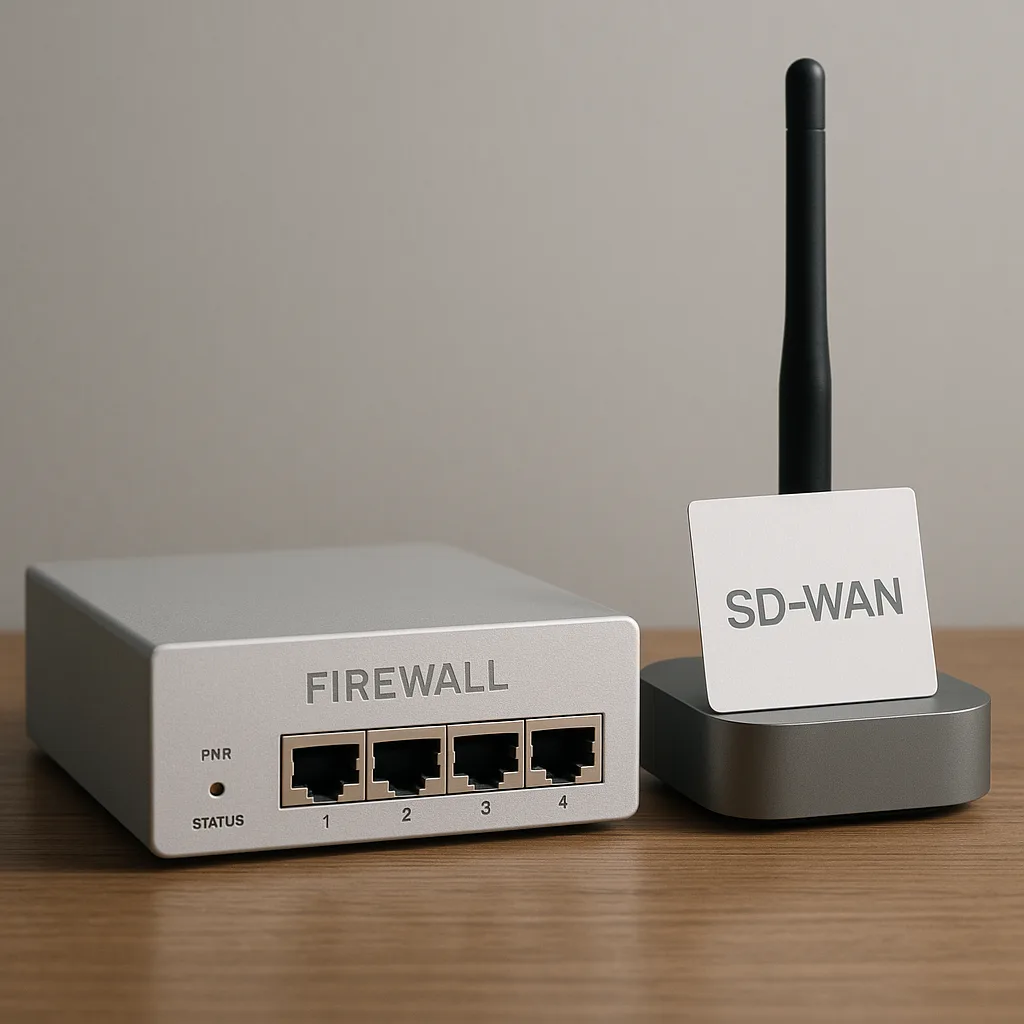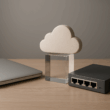SD‑WAN and firewalls are no longer separate conversations. Organisations use SD‑WAN to optimise and control wide‑area connectivity, while firewalls remain the principal perimeter and inspection control. This article explains the technical differences between a firewall and SD‑WAN, why vendors now bundle or integrate the two, and practical patterns and pitfalls when you plan an integrated deployment.
What a firewall does (short definition)
A firewall is a network device or service that monitors and enforces rules for traffic entering and leaving a network; modern variants used in enterprise practice are called NGFWs (next‑generation firewalls). NGFW (next‑generation firewall): a firewall that adds application awareness, deeper packet inspection and integrated threat prevention to traditional stateful filtering.
Firewalls are primarily a security control. At the simplest level they enforce allow/deny rules and NAT; NGFWs add application‑level controls, intrusion prevention systems (IPS), and tighter policy tools that support zero‑trust models. Because a firewall inspects packets at layer‑7 (the application layer) it can block or throttle specific apps and surface indicators of compromise for security monitoring. Cisco material describes NGFWs as providing visibility, control and prevention at the network edge; Juniper documentation likewise positions NGFWs as the edge enforcement point when combined with SD‑WAN.
Operationally, firewalls are usually stateful, require careful policy design and, when used across many branches, need tools for consistent policy distribution and logging. That is why enterprises either centralise firewall management (management consoles) or adopt cloud‑delivered firewall services when they scale.
What SD‑WAN is and what it solves
SD‑WAN (software‑defined wide area network) is a software approach to managing the WAN so routing and path selection are centrally controlled rather than scattered across individual routers. Cisco describes SD‑WAN as a centralised, software‑driven way to scale cloud and branch connectivity that is agnostic to transport (MPLS, broadband, LTE, etc.).
The practical benefits are: centralised configuration, application‑aware path selection (so voice and SaaS traffic are steered onto the best link), and simpler operational workflows for adding or reconfiguring sites. SD‑WAN appliances or virtual edges carry a control plane that distributes policies and a forwarding (data) plane that applies them at each site.
Security was not an afterthought: modern “secure SD‑WAN” solutions embed or integrate firewall capabilities. Vendors offer either on‑box NGFW features, virtualised firewall modules, or service insertion to route traffic through a separate security device or cloud service. Juniper and Cisco materials both note that SD‑WAN supports service chaining (for example to an NGFW or cloud security service) and that a centralised management plane helps enforce consistent policies across many edges.
“SD‑WAN is a software‑defined approach to managing the wide‑area network.” — Cisco
Key technical differences
Purpose: A firewall enforces security policy and inspects traffic; SD‑WAN controls connectivity and application path selection across multiple links. The distinction is functional rather than strictly hardware: both can exist on the same device or as separate appliances.
Control plane vs data plane: SD‑WAN separates control (central policy and orchestration) from the data plane (local forwarding), which enables rapid roll‑out of routing and QoS policies across many sites. Firewalls focus on inspection and enforcement in the data plane, with management consoles providing central policy distribution for security rules.
Statefulness and inspection depth: Traditional stateful firewalls track connection state and apply rules accordingly. NGFWs add deep packet inspection and application signatures, which is heavier on CPU and can affect throughput. SD‑WAN features (like path selection and WAN optimisation) are designed to be low‑latency and fast; inserting heavy inspection into every packet path requires either appropriately sized edge appliances or service chaining to dedicated NGFWs.
Policy model: SD‑WAN policies are usually expressed as application or flow path policies (which link to use, preferred interface, failover). Firewall policies are written as security rules (allow/deny, IPS signatures, URL filters). When merged, the SD‑WAN policy decides the path and the firewall policy decides whether the flow is permitted or inspected further.
Performance trade‑offs: Combining SD‑WAN and NGFW functions on the same edge device simplifies operations but raises capacity and licensing questions—inspectors need CPU and state synchronisation for HA. Cisco community guidance highlights the need for state synchronisation to prevent traffic loss during failover in combined deployments.
Integration patterns
There are three practical ways organisations integrate firewalls and SD‑WAN: on‑box integration (SD‑WAN edge includes NGFW), service insertion (traffic steered through a firewall appliance or virtual function), and cloud/managed firewall (FWaaS or SASE models). Each has clear trade‑offs in complexity, cost and operational overhead.
- On‑box NGFW: simplest operations and single appliance management; requires a capable edge appliance and appropriate licences. Juniper and Cisco both ship solutions where NGFW features are available alongside SD‑WAN.
- Service insertion (chaining): SD‑WAN steers traffic to a dedicated firewall or virtualised NGFW for inspection; this reduces CPU load on the edge but adds a hop and more complex routing and state management.
- Cloud FWaaS / SASE: traffic (especially Internet/SaaS) is routed to a cloud security POP which applies firewall and CASB functions; good for central control but introduces latency and policy‑placement decisions.
Integration objectives should be explicit: where do you need full layer‑7 inspection, where is simple path steering sufficient, and which flows must remain local for latency or compliance reasons? The list below summarises quick decision criteria:
- Latency‑sensitive apps need local steering without heavyweight inspection.
- Highly regulated or monitored services may require centralised inspection (or a dedicated NGFW at HQ).
- Small branches often favour integrated on‑box NGFW for simplicity.
Implementation considerations and common pitfalls
Policy consistency and orchestration: If you have separate SD‑WAN and firewall products, ensure the management planes can express the same intent. Juniper white papers and Cisco design guides flag orchestration and integration as primary implementation questions; inconsistent policy placement leads to gaps.
State synchronisation and HA: Firewalls performing deep inspection maintain session state. If SD‑WAN failover or asymmetric routing sends return traffic via a different device, you will see broken flows unless state is synchronised or service‑insertion is symmetric. Cisco guidance on catalyst SD‑WAN with NGFWs highlights state sync and traffic symmetry as an explicit HA concern.
Sizing and licences: Integrating NGFW functions increases CPU, memory and throughput requirements on branch appliances. Manufacturers document performance profiles; use those figures rather than guesswork and budget for future growth and signature updates.
Visibility and telemetry: Centralised SD‑WAN controllers give you routing and quality telemetry; the security stack must feed logs to a SIEM or management console. Make sure log formats and retention policies are agreed between networking and security teams.
Operational separation: Organisations often retain separate teams for networking and security. Plan change control, testing and rollback paths that cross these teams, don’t assume a single group can own every policy change without a runbook.
UK specific caveat
In the UK, when you route branch Internet traffic to cloud POPs or FWaaS services consider local POP placement and ISP variability (FTTC vs FTTP vs leased lines). SD‑WAN will use whatever transport is available, but performance and resilience depend on the local ISP profile.
Final Thoughts
Firewall vs SD‑WAN is not an either/or decision. SD‑WAN delivers centralised control, transport diversity and application steering; firewalls deliver inspection and enforcement. For most the practical solution is an integrated model, either on‑box NGFW where branches are small and latency matters, or SD‑WAN with service‑insertion or cloud firewall for larger, security‑sensitive deployments. Plan for consistent policy, state synchronisation for HA and realistic appliance sizing; that will avoid the common operational pitfalls.








